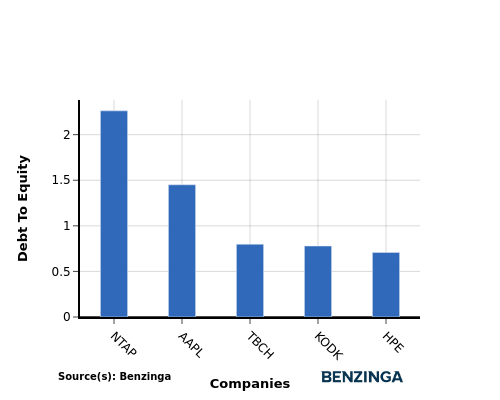In today's rapidly changing and highly competitive business world, it is imperative for investors and industry observers to carefully assess companies before making investment choices. In this article, we will undertake a comprehensive industry comparison, evaluating Apple AAPL vis-à-vis its key competitors in the Technology Hardware, Storage & Peripherals industry. Through a detailed analysis of important financial indicators, market standing, and growth potential, our goal is to provide valuable insights and highlight company's performance in the industry.
Apple Background
Apple is among the largest companies in the world, with a broad portfolio of hardware and software products targeted at consumers and businesses. Apple's iPhone makes up a majority of the firm sales, and Apple's other products like Mac, iPad, and Watch are designed around the iPhone as the focal point of an expansive software ecosystem. Apple has progressively worked to add new applications, like streaming video, subscription bundles, and augmented reality. The firm designs its own software and semiconductors while working with subcontractors like Foxconn and TSMC to build its products and chips. Slightly less than half of Apple's sales come directly through its flagship stores, with a majority of sales coming indirectly through partnerships and distribution.
| Company | P/E | P/B | P/S | ROE | EBITDA (in billions) | Gross Profit (in billions) | Revenue Growth |
|---|---|---|---|---|---|---|---|
| Apple Inc | 27.37 | 38.80 | 6.67 | 58.74% | $45.91 | $58.27 | 3.95% |
| Super Micro Computer Inc | 13.80 | 3.02 | 0.96 | 5.29% | $0.4 | $0.67 | 54.93% |
| Hewlett Packard Enterprise Co | 6.01 | 0.65 | 0.54 | 2.39% | $1.11 | $2.29 | 16.27% |
| NetApp Inc | 14.10 | 15.79 | 2.47 | 31.69% | $0.45 | $1.15 | 2.18% |
| Pure Storage Inc | 124.81 | 9.65 | 4.19 | 3.12% | $0.09 | $0.59 | 11.4% |
| Western Digital Corp | 9.12 | 0.91 | 0.69 | 4.89% | $0.96 | $1.52 | 41.33% |
| Eastman Kodak Co | 5.89 | 0.67 | 0.47 | 2.46% | $0.05 | $0.05 | -3.27% |
| Turtle Beach Corp | 13.24 | 1.71 | 0.58 | 18.11% | $0.03 | $0.05 | 46.76% |
| AstroNova Inc | 17.65 | 0.74 | 0.45 | 0.26% | $0.0 | $0.01 | 7.65% |
| Average | 25.58 | 4.14 | 1.29 | 8.53% | $0.39 | $0.79 | 22.16% |
By closely examining Apple, we can identify the following trends:
-
The current Price to Earnings ratio of 27.37 is 1.07x higher than the industry average, indicating the stock is priced at a premium level according to the market sentiment.
-
With a Price to Book ratio of 38.8, which is 9.37x the industry average, Apple might be considered overvalued in terms of its book value, as it is trading at a higher multiple compared to its industry peers.
-
The stock's relatively high Price to Sales ratio of 6.67, surpassing the industry average by 5.17x, may indicate an aspect of overvaluation in terms of sales performance.
-
The Return on Equity (ROE) of 58.74% is 50.21% above the industry average, highlighting efficient use of equity to generate profits.
-
The company has higher Earnings Before Interest, Taxes, Depreciation, and Amortization (EBITDA) of $45.91 Billion, which is 117.72x above the industry average, indicating stronger profitability and robust cash flow generation.
-
Compared to its industry, the company has higher gross profit of $58.27 Billion, which indicates 73.76x above the industry average, indicating stronger profitability and higher earnings from its core operations.
-
The company is witnessing a substantial decline in revenue growth, with a rate of 3.95% compared to the industry average of 22.16%, which indicates a challenging sales environment.
Debt To Equity Ratio

The debt-to-equity (D/E) ratio is a key indicator of a company's financial health and its reliance on debt financing.
Considering the debt-to-equity ratio in industry comparisons allows for a concise evaluation of a company's financial health and risk profile, aiding in informed decision-making.
In light of the Debt-to-Equity ratio, a comparison between Apple and its top 4 peers reveals the following information:
-
When compared to its top 4 peers, Apple has a moderate debt-to-equity ratio of 1.45.
-
This implies that the company maintains a balanced financial structure with a reasonable level of debt and an appropriate reliance on equity financing.
Key Takeaways
For Apple, the PE, PB, and PS ratios are all high compared to its peers in the Technology Hardware, Storage & Peripherals industry, indicating that the stock may be overvalued. On the other hand, Apple's high ROE, EBITDA, and gross profit suggest strong profitability and operational efficiency relative to its industry peers. However, the low revenue growth rate implies that Apple may be facing challenges in expanding its top line compared to its competitors in the sector.
This article was generated by Benzinga's automated content engine and reviewed by an editor.
Edge Rankings
Price Trend
© 2025 Benzinga.com. Benzinga does not provide investment advice. All rights reserved.
Trade confidently with insights and alerts from analyst ratings, free reports and breaking news that affects the stocks you care about.